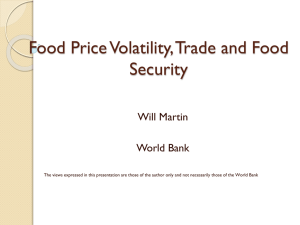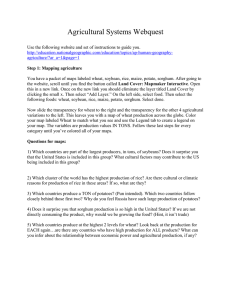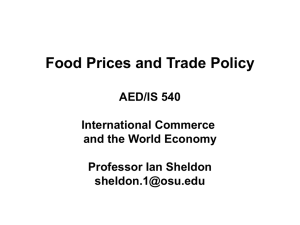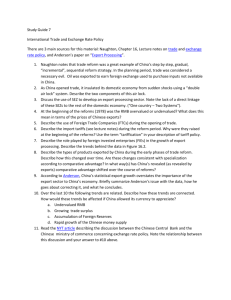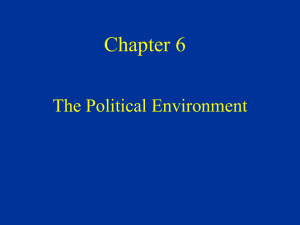Export Restrictions and Price Insulation during Commodity Price Booms 5645
advertisement
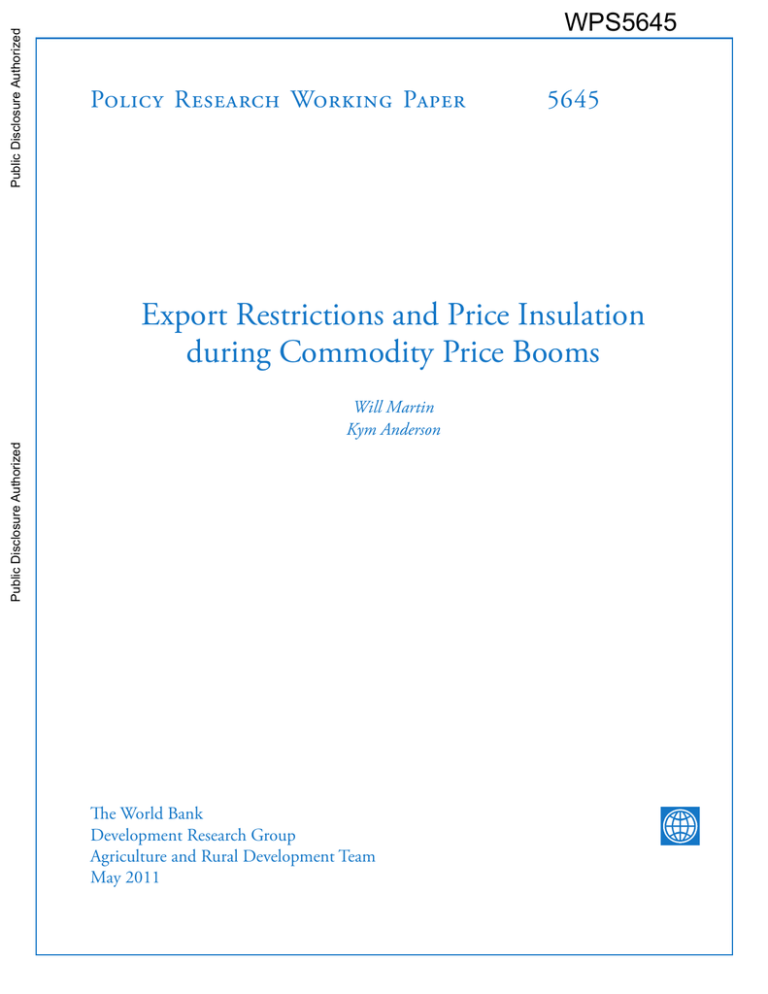
Public Disclosure Authorized Policy Research Working Paper Public Disclosure Authorized 5645 Export Restrictions and Price Insulation during Commodity Price Booms Will Martin Kym Anderson Public Disclosure Authorized Public Disclosure Authorized WPS5645 The World Bank Development Research Group Agriculture and Rural Development Team May 2011 Policy Research Working Paper 5645 Abstract For individual countries, variable trade barriers can be used to reduce the volatility of domestic relative to world prices. If this is done by countries accounting for a large share of the market, its effect is offset by increases in world price volatility. This study shows the nature of the resulting collective action problem, with the policy being ineffective on average in stabilizing domestic prices while increasing the volatility of the income transfers from terms-of-trade changes. A simple approach to assessing the contribution of insulation to the price increases is developed and used with new estimates of agricultural distortions to assess its contribution to the price spikes in 1972–74 and 2006–08 for rice and wheat. The analysis suggests that 45 percent of the increase in rice prices in 2006-08, and 30 percent of the increase in wheat prices, was due to insulating behavior. One sign of progress since 1972–74 was a substantial reduction in the extent of price-insulating behavior by the industrial countries. This provides little stabilizing benefit in the rice market because countries not classifying themselves at the World Trade Organization as developing account for only 3 percent of world rice consumption. But it does offer some benefit for the wheat market where non-developing countries account for 27 percent of consumption. This paper is a product of the Agriculture and Rural Development Team, Development Research Group. It is part of a larger effort by the World Bank to provide open access to its research and make a contribution to development policy discussions around the world. Policy Research Working Papers are also posted on the Web at http://econ.worldbank.org. The author may be contacted at wmartin1@worldbank.org. The Policy Research Working Paper Series disseminates the findings of work in progress to encourage the exchange of ideas about development issues. An objective of the series is to get the findings out quickly, even if the presentations are less than fully polished. The papers carry the names of the authors and should be cited accordingly. The findings, interpretations, and conclusions expressed in this paper are entirely those of the authors. They do not necessarily represent the views of the International Bank for Reconstruction and Development/World Bank and its affiliated organizations, or those of the Executive Directors of the World Bank or the governments they represent. Produced by the Research Support Team Export Restrictions and Price Insulation during Commodity Price Booms Will Martin and Kym Anderson* JEL Codes: F13, O13, Q02. Keywords: food price volatility; food prices; rice prices; wheat prices; commodity price instability; collective action problem; agricultural price distortions; agricultural trade policy; price insulation; World Trade Organization; WTO. *Will Martin is Research Manager, Agricultural and Rural Development, Development Research Group, World Bank, Washington DC; Kym Anderson is George Gollin Professor of Economics, University of Adelaide, Australia. The authors are grateful to Signe Nelgen for excellent research assistance. The research on which this paper is based benefitted from support by the Multi-Donor Trust Fund for Trade. The views expressed are the authors’ alone and not necessarily those of the World Bank. An earlier version of this paper was presented at the 2011 Allied Social Sciences Association meetings, January 2010, Denver. A condensed version is forthcoming in American Journal of Agricultural Economics 94(1), January 2012. Export Restrictions and Price Insulation during Commodity Price Booms Will Martin and Kym Anderson Prices of grains and other storable commodities are characterized by long periods in the doldrums, punctuated by short but intense price spikes (Deaton and Laroque 1992). Those spikes are of concern not least because they can have large impacts on poverty in developing countries (Ivanic and Martin 2008). Accounts of the food price spikes of 1973-74, 2006-8 and 2010-11 include discussion of a wide range of contributing factors such as exogenous shocks to supply or demand, below-trend stock levels, speculative behavior, and trade policy responses to the shock. Johnson (1975) emphasizes policy responses in his analysis of the 1973-74 price spike, as have most of the available assessments of the 2006-08 shock (Baffes and Haniotis 2010; Bouët and Laborde 2010; Hochman et al. 2010; Timmer 2010; Robles, Torero and von Braun 2008). Several suggest that export restrictions (and maybe also import subsidies) played an important role, just as intensified export subsidies and triggered import restrictions played a significant role in 1986-8 when international food prices slumped. However, we are unaware of any attempts to quantify the aggregate contribution across countries of trade policy responses to international price surges. In this paper, we address this issue directly. Following Freund and Özden (2008), we assume national trade policy responds to the risk of losses for significant groups by insulating the domestic market to some extent from international price fluctuations for staple foods. This is consistent with the behavior of many governments, and it provides an economic rationale for the econometric estimation of price transmission elasticities. We use a standard conceptual framework to derive a simple equation that provides at least a rough way to estimate the contribution of market-insulating policy behavior to international price spikes for homogenous farm products. We then examine evidence from two major upward price spikes (1973-4 and 2006-8) for the key commodities of wheat and rice. Policy implications are drawn out in the final section of the paper. 2 International Price Volatility and National Policy Responses Consider a weather- (or financial market-) induced exogenous shock to the global market for a food staple that causes a surge in its international price. Suppose that, in response, exporting countries impose or raise an export tax or tighten export restrictions (or lower any export subsidy), and importing countries reduce their tariff or other import restrictions (or introduce or raise an import subsidy) to reduce the rise in their domestic price. If both sets of countries try to reduce the impact of the shock on domestic prices to the same extent, their attempts will be collectively futile. This is very easy to show graphically in the case where first the exporters and then the importers seek to completely block the effect of an increase in the price of food resulting from an initial shock. For an individual small exporting country, the effect of the increase in its (explicit or implicit) export tax it is to reduce the domestic price relative to the newlyraised world price. The same effect occurs in a small importing country that reduces its (explicit or implicit) import tariff. If a sufficient number of exporting countries intervene in this way, their export restrictions cause the world price of the good to rise further, thereby reducing the impact of each country’s initial action on its domestic price. This situation is depicted in Figure 1, where the excess supply curve of the exporting country group is ES and the excess demand curve of the importing country group is ED following the exogenous shock but prior to any changes to trade restrictions. If an export tax is then applied, the world price needed to obtain any given level of exports is higher, since part of the export price is paid to the exporting government. This is reflected in the ES curve moving up to ES,1 the effects of which are to raise the world price from Pw to Pw and lower the domestic price from Pw to Pd. 1 If quantitative export restrictions were imposed instead, the rights to export become valuable, with the holders of the export rights receiving the benefits that would accrue to the government if an export tax had been used. 3 Figure 1. Key impacts of an export restriction ES Pw ES Pw c Pw Pd b a ED 0 In the situation depicted in Figure 1, the exporting country group gains from the improvement in their export price. However, production incentives are reduced and consumers have an incentive to increase their demand, even though export prices are higher,. The global social cost associated with these incentives is given by the triangle abc. That can be subdivided into a loss to private agents in the importing group of area bcPw’Pw, a loss to private agents in the exporting group of area baPdPw, and a gain to the government or export quota holders in the exporting country group of area acPw’Pw. Whether the exporting countries as a group enjoy a net gain from restricting exports depends on whether the upper rectangle (the terms of trade gain) is larger than the lower triangle (the social cost). Since the social costs rise with the square of the export tax equivalent (P'w – Pd), while the terms of trade gain is likely to rise roughly linearly with the rate, the benefits to the exporter group will become negative if the export tax rate becomes sufficiently large. By contrast, importing 4 countries unambiguously lose from the export restrictions as they transfer income to the exporter and reduce net consumption.2 If policy makers in importing countries were concerned primarily about the impact on their terms of trade of the imposition of export restrictions, they might respond by raising tariffs on their imports. However, during episodes of international food price spikes, the response has typically been the opposite: tariffs on food imports are reduced in an attempt to avoid adverse impacts on domestic consumers. This response reduces the cost imposed on the importing country group by its own protectionist barriers. However, it will compound the increase in world prices resulting from the initial price shock and the policy response by exporters. It will also add to the exporter group’s terms-of-trade benefits resulting from the initial upward price shock and from its own imposition of export restrictions. In Figure 2, exporters attempt to completely offset the impact of the initial increase in the price of the good by shifting the ES curve to ES'. Importers seek to achieve the same insulation by reducing tariffs (or paying import subsidies) so as to shift the ED curve to ED'. As is evident in Figure 2, the combined effect of these policy changes is to leave domestic prices in both importers and exporters at the postshock level Pw and to raise the international price from Pw' to Pw''. Despite the attempts of both the importer and exporter country groups to fully offset the original increase in price to Pw, domestic prices and quantities unchanged at their post-shock level (P0 in the Figure). The only effect of these policies is to compound the terms-oftrade shift against the importing country group and in favor of the exporting group, generating a transfer from the former to the latter of (Pw''-P0).Q in Figure 2 (in addition to that caused by the initial exogenous shock). This is in sharp contrast with a move from autarchy towards free trade, which is able to reduce price risk through diversification of market outlets very substantially since the correlations between commodity output shocks across countries are very limited (Johnson 1975). 2 See Martin (1997) for approaches to measuring this welfare impact. 5 Figure 2. Impacts of equal export barrier increases and import barrier reductions ES Pw Pw ES Pw P0 ED ED 0 Q Insulation generates a classic collective-action problem akin to when a crowd stands up in a stadium to get a better view: no one gets a better view by standing, but any that remain seated get a worse view. This collective action is, unfortunately, not just completely ineffective—it generates an international public ‘bad’ by amplifying the volatility in the world price of the product, and hence the volatility of the income transfers associated with terms-of-trade changes. To assess the implications of price insulation on a homogenous product’s international price, p*, we begin with the global market equilibrium condition: (1) Σi (Si(pi)+vi) - ΣiDi(Pi) = 0 where Si is the supply in region i; pi is the region’s producer price; vi is a random production shift variable for that region; Di is demand in region i (assumed to be not subject to shocks from year to year); and Pi is the consumer price in region i. We assume that pi = (1+tp).p* where tp is the distortion rate between the producer price and international price, and that Pi = (1+tc).p* where tc is the distortion rate between the consumer price and international price. With a focus on border measures, we can use a single variable for the power of the trade tax equivalent, T = (1+t) where t = tp = tc. 6 Totally differentiating equation (1), rearranging it, and expressing the results in percentage change form, yields the following expression for the impact of a set of changes in trade distortions on the international price: - (2) - where is the proportional change in the international price; is an exogenous stochastic shock to output such as might result from better or worse weather than average; ηi is the elasticity of demand; γi is the elasticity of supply; Gi is the share at international prices of country i in global demand; and Hi is the share of country i in global production. That is, the impact on the international price of a change in trade distortions in country i depends on the importance of that country in global supply and demand, as well as the responsiveness of its production and consumption to price changes in the country, as represented by γi and ηi. With large proportional changes in trade policies and other shocks, the effects are no longer purely additive as in equation (2) and we need to take into account the interaction between these two proportional changes. A notable implication of equation (2) is that a uniform policy response by all countries ( is the same for all i) will make the elasticities of supply and demand irrelevant to the impact on international prices: if all countries alter their distortions by a uniform amount, the international price will change by an exactly-offsetting amount, leaving domestic prices unchanged. If we assume that output cannot respond in the short run and that inventory levels are low enough that stock adjustments have limited effect, then γi=0. If we further assume that the national elasticities of final demand for the product (ηi) are the same across countries, then equation (2) suggests we can estimate the contribution to international price changes resulting from changes in national trade policies as simply the negative of the consumption-weighted global average of the Tˆi ' s . Incidentally, if we consider the case where protection varies endogenously in response to changes in the international price, trade distortions are no longer an exogenous source of shocks, and international prices will change only in response to exogenous shocks such as weather-induced shocks to output. In this case, the counterpart to equation (2) is: 7 (3) i Hi vi i (Gi ηi - Hi γi where θi is the elasticity of transmission from the international price to the consumer price in country i; and ϕi is the elasticity of transmission from the international price to the domestic producer price. Where we focus only on trade measures, such that these elasticities of price transmission are the same, it follows that the impact of price insulation on the international price is larger the smaller are those price transmission elasticities. If the short-run elasticity of price transmission is, for instance, 0.5 in all countries (a finding in line with that of Anderson et al. (2010) for key commodities such as rice and wheat since 1985, and consistent with the results in Tyers and Anderson (1992) for earlier periods), the impact of any exogenous shock on the international price will be twice as large as it would be with full price transmission. In this situation, the variance of the international price will be four times as large as it would be in the absence of price insulation. If all countries used the price transmission elasticity of 0.15 implied by the 85 percent compensating duty under the proposed Special Safeguard Mechanism (Hertel, Martin and Leister 2010), then the impact of any shock on the international price would be magnified by a factor of 6.7, and the variance by a factor of 44. The Uruguay Round agreement of the WTO attempted to address this problem by banning variable import levies and other directly insulating policies, and by counting protection provided by measures involving administered prices under both the market access and domestic support measures. However, the Uruguay Round bindings on import tariffs and subsidies are at levels well above historically applied rates in most cases, providing room for countries to raise applied rates without infringing their WTO commitments. Furthermore, no effective disciplines yet apply in the WTO to variations in export restrictions. With that in mind, we turn now to seeing how much of a contribution insulating behavior of national governments had on international prices of rice and wheat in price spike periods before and after the Uruguay Round, that is, around 1974 and 2008. 8 The Cases of Rice and Wheat The two food commodities that have received the most attention because of price surges are the key staples of wheat and rice. The length of their international price spikes around 1974 were broadly similar to those around 2008, but the height of the spike – particularly for rice – was greater in 1974. The recent price rises were more gradual except in the final months, so we consider an extra year in the lead-up to the 2008 spike. Estimates of the Ti’s are available for all key rice and wheat countries, in the form of nominal assistance coefficients (NACs), from three sources. Anderson and Valenzuela (2008) provide them to 2004 for developing countries and to 2007 for high-income countries (summarized in Anderson 2009). They are similarly available for high-income countries for 2008 in OECD (2010). For developing countries, Anderson and Nelgen (2010b) provide estimates based on FAO and World Bank data on producer and border prices, respectively, for 2005 to 2008. The most-recent developing country estimates are less reliable than the NAC estimates in Anderson and Valenzuela (2008), for several reasons. One is that the coverage is not as extensive, because domestic prices are not available for some countries. Another is that the FAO’s producer prices and World Bank international prices are not always as reliable as previously-used domestic and border prices from national statistical agencies. The FAO producer prices in US current dollars (FAO 2010) were converted into an index set at 100 for 2004, and the 2004 US dollar prices in Anderson and Valenzuela (2008) updated using the changes in these indexes through 2008. Likewise, the Thailand 5 percent broken rice and Canadian wheat prices from the World Bank were converted to indexes set at 100 for 2004, and the 2004 border prices in Anderson and Valenzuela (2008) updated using changes in those indexes through 2008. These NAC estimates are reported in Table 1 for the two upward price spike periods. For each of the regions shown, as well as for the world as a whole, the patterns are strikingly similar: falls in the NAC as the international price rose. The proportional changes in NACs in the first half of each spike differ across products and 9 country groups, however. As shown in Figure 3, the proportional change was very similar for high-income and developing countries in the 1970s spike, albeit only half as large for wheat as for rice. In the more recent spike, the proportional change for high-income countries was somewhat smaller in the case of rice and very much smaller in the case of wheat than for developing countries. Assuming that output was able to respond only to a limited degree in the first half of each spike, and that the national elasticities of demand (including stock demand) are similar across countries for each product, we set the γi’s to zero and use equation (2) to estimate the contribution to international price changes of priceinsulating behavior resulting from national price-insulating policy behavior is the (negative of the) consumption-weighted global average change in the national Ti’s. For rice the cumulative decline shown in the world row of Table 1 was 46 percent between 2005 and 2008, which is in the same order of magnitude as the decline between 1972 and 1974 of 58 percent. For wheat, the globally-weighted Tˆ was -28 percent over the 2005-08 period, compared with -30 percent in 1972-74. According to World Bank price data, the world price of rice increased by 127 percent between 2005 and 2008, and the price of wheat increased by 114 percent. By taking the interactions between the proportional changes in trade policy and other factors into account, we can estimate the magnitude of the non-trade shocks. Comparing these with the estimated trade shocks suggest that in 2005-08 more than 45 percent of the explained change in the international price of rice is due to the changes in border restrictions that countries used in an attempt to insulate themselves from the initial increases in price. For wheat, the corresponding estimate was 29 percent. In 2008 alone, the change in protection on rice explains almost half of the 90 percent increase in rice prices observed for that year. One important and encouraging difference between the 2008 price surge and the earlier one around 1974 is an apparent sharp reduction in the extent of price insulation in high-income countries. For rice, their NAC declined 45 percent between 1973 and 1974, while it fell only 8 percent between 2007 and 2008. In the case of wheat, the comparable numbers were 28 percent and 12 percent. While desirable, the reduction in insulating behavior by these countries has a very limited beneficial impact in the world market for rice as members not classifying themselves as 10 developing countries in agriculture account for only 3 percent of world rice consumption. For wheat, where these countries account for 27 percent of world consumption, the benefit is likely somewhat greater. However, it is clear from these trade shares that the key trade policy influence on the stability of world markets is what happens in developing countries. Within the group of developing countries, there are also very substantial differences in the extent of price insulation. As shown in Figure 4, it appears that domestic price rises for wheat in the 2006-8 period were restrained much more in Asia than in other world regions. This suggests that—in contrast with the case considered in Figures 1 and 2—price insulating policies may not have been completely ineffective in stabilizing prices in all regions. Rather, their effect may have been to reduce the volatility of domestic prices in some regions, while increasing this volatility in others. Are rice and wheat representative of other farm products in terms of insulating behavior by governments? There is no global database for all farm products for the most recent spike period, but there is for the upward spike of 1974-6 and the slump of 1984-8. Anderson and Nelgen (2010a) decompose the nominal rate of assistance (NRA) estimates, for the overall agricultural sector of all 75 countries in the Anderson and Valenzuela (2008) database, into the various border and domestic measures for developing and high-income countries. The annual estimates summarized for the upward spike period of 1972-76, and the downward spike period of 1984-8, are reported in Table 2. In both of these periods, export restrictions were the dominant instrument for developing countries; they became more and then less important in the upward spike period of 1972-76, and conversely in the downward spike period of 1984-88. In highincome countries there were virtually no taxes or other restrictions on exports, but export subsidies followed the same path as import tariffs over those spike periods: Ushaped during the upward spike, inverted U-shaped in the downward spike. Together these estimates suggest the experiences with rice and wheat were not inconsistent with the pattern for farm products in general, especially when bearing in mind that the NRA estimates in Table 2 include numerous nontradable products whose NRAs tend 11 to remain close to zero and hence dampen year-to-year fluctuations in the aggregate estimates. Conclusions and Policy Implications Trade policy changes—and particularly export restrictions—are frequently discussed as contributing factors to food price surges. This paper examines the role of trade barriers in contributing to surges. It first highlights the collective action problem associated with the use of these measures as stabilization policies, noting that the use of these measures by all countries would be ineffective in stabilizing domestic prices, while magnifying international price instability associated with exogenous shocks to food markets. We develop a simple approach to assessing the contribution of price insulating trade policy actions on international price changes for individual agricultural commodities, and use this approach to estimate the extent to which changes in trade policy measures have contributed to price surges for the key staple foods of rice and wheat. Our analysis shows that changes in trade policies contributed very substantially to the increases in world prices of these staple crops in both the 1973-4 and 2006-8 price surges. In the 2006-8 surge, insulating policies affecting the market for rice explain 45 percent of the increase in the international rice price, while almost 30 percent of the observed change in the international price of wheat during 2006-08 can be explained by the changes in border protection rates. The evidence in Figure 3 suggests that at least high-income countries altered their NACs less in the most recent price spike period than in the two previous ones. That is not inconsistent with the fact that the Uruguay Round Agreement on Agriculture, which came into force with the creations of the WTO in 1995, involved commitments to bind tariffs and subsidies. Nor is the finding that developing countries are still very active users of variable border measures and especially export restrictions, given (a) that developing country bindings are well above applied rates and (b) that the WTO has no effective restrictions on agricultural export measures. However, more-comprehensive empirical analysis over a broader range of products is 12 needed before it would be possible to say how much of these changes can be attributed to the presence or absence of WTO disciplines. Since bindings on import tariffs and subsidies even for many high-income countries were made at levels well above historically applied rates, plenty of ‘wiggle room’ for countries to raise applied rates without infringing their commitments to other WTO members remains. Furthermore, with no effective disciplines yet applying to export restrictions, the WTO membership is yet to address the other half of this beggar-thy-neighbor problem. And if a Special Safeguard Mechanism were to be introduced as part of a Doha Development Agenda agreement, the problem would be become even worse (Hertel, Martin and Leister 2010). An obvious solution is to seek a collective agreement to limit the extent of price-insulating policy use. Perhaps the most-recent experience with price spikes in 2006-8, and again in 2010-11, will make WTO members more willing to address this issue. 13 References Anderson, K. (ed.) 2009. Distortions to Agricultural Incentives: A Global Perspective, 1955–2007, Washington DC: Palgrave Macmillan and World Bank. Anderson, K., J.L. Croser, D. Sandri and E. Valenzuela 2010. ‘Agricultural Distortion Patterns Since the 1950s: What Needs Explaining’, Ch. 2 in K. Anderson (ed.), The Political Economy of Agricultural Price Distortions, Cambridge and New York: Cambridge University Press. Anderson, K. and S. Nelgen 2010a. ‘How do Governments Respond to Food Price Spikes? Lessons from the Past’, Journal of International Commerce, Economics and Policy 1(2): 265-85, December. Anderson, K. and S. Nelgen 2010b. ‘Trade Barrier Volatility and Agricultural Price Stabilization’, CEPR Discussion Paper 8102, London, November and World Bank Policy Research Working Paper 5511, Washington DC, December. Anderson, K. and E. Valenzuela 2008. Global Estimates of Distortions to Agricultural Incentives, 1955 to 2007, www.worldbank.org/agdistortions Baffes, J. and T. Haniotis 2010. ‘Placing the 2006/08 Commodity Price Boom into Perspective’, Policy Research Working Paper 5371, World Bank, Washington DC. Bouët, A. and D. Laborde 2010. ‘Economics of Export Taxation in a Context of Food Crisis: A Theoretical and CGE Approach Contribution’, Discussion Paper 00994, International Food Policy Research Institute, Washington DC. Deaton, A. and G. Laroque 1992. ‘On the Behavior of Commodity Prices’, Review of Economic Studies 59(198): 1-23, January. FAO (2010), FAOSTAT database, accessed at www.fao.org on 21 September 2010. Freund, C. and C. Özden 2008. ‘Trade Policy and Loss Aversion’, American Economic Review 98(4): 1675-1691, September. Hertel, T., W. Martin, and A. Leister 2010. ‘Potential Implications of a Special Safeguard Mechanism in the World Trade Organization: The Case of Wheat’, World Bank Economic Review 24(2): 330–59. Hochman, G., D. Rajagopaly, G. Timilsina and D. Zilberman 2010. ‘Quantifying the Causes of the Global Food Commodity Price Crisis’, Policy Research Working Paper, World Bank, Washington DC (forthcoming). Ivanic, M. and W. Martin 2008. ‘Implications of Higher Global Food Prices for Poverty in Low-Income Countries’ Agricultural Economics 39:405-16. Johnson, D.G. 1975. ‘World Agriculture, Commodity Policy, and Price Variability’, American Journal of Agricultural Economics 57(5): 823-28, December. OECD 2010. Producer and Consumer Support Estimates, OECD Database 19862009. http://www.oecd.org. 14 Robles, M., M. Torero, and J. von Braun 2009. ‘When Speculation Matters’, Issue Brief 57, International Food Policy Research Institute, Washington DC, February. Timmer, P. 2010. ‘Reflections on Food Crises Past’ Food Policy 35:1-11. Tyers, R. and K. Anderson 1992. Disarray in World Food Markets: A Quantitative Assessment¸ Cambridge and New York: Cambridge University Press. 15 Figure 3: Percentage changes in Ti’s for rice and wheat,a high-income and developing countries, 1972-74, 1984-86, and 2005-08. (a) Rice 80 60 40 20 Rice HICs 0 -20 1972-74 1984-86 2005-08 Rice DCs -40 -60 -80 (b) Wheat 60 50 40 30 20 10 Wheat HICs 0 Wheat DCs -10 1972-74 1984-86 2005-08 -20 -30 -40 -50 Source: Anderson and Nelgen (2010b). 16 Figure 4: Indexes of real international and producer prices of rice and wheat, developing countries’ unweighted average, 2006-2010 (2005=100) a) Wheat 250 200 Producer Price Asia Producer Price Africa Producer Price Latin America International Reference Price 150 100 2006 2007 2008 2009 2010 50 0 b) Rice 250 200 Producer Price Asia Producer Price Africa Producer Price Latin America International Reference Price 150 100 2006 2007 2008 2009 2010 50 0 Source: FAOSTAT producer prices (www.fao.org) and international reference prices from the World Bank’s Prospects Group (econ.worldbank.org). 17 Table 1: Weighted Average Ti’s for Rice and Wheat,a 1972-76, and 2005-08 a Rice 1972 1973 1974 1975 1976 2005 2006 2007 2008 World 1.30 0.93 0.54 0.90 0.98 1.33 1.24 1.15 0.72 High-income countries 3.06 2.29 1.26 1.71 2.35 3.35 2.66 2.28 2.10 Developing countries 1.03 0.73 0.45 0.82 0.87 1.25 1.19 1.10 0.66 ASIA 1.03 0.71 0.42 0.82 0.86 1.24 1.17 1.08 0.66 Africa 0.97 0.60 0.38 0.66 0.86 0.99 1.09 1.29 0.70 LAC 1.00 1.08 0.89 0.90 0.98 1.51 1.46 1.39 0.86 Wheat 1972 1973 1974 1975 1976 2005 2006 2007 2008 World 1.15 0.81 0.81 0.95 0.94 1.19 1.14 1.02 0.86 High-income countries 1.11 0.83 0.80 0.90 0.92 1.20 1.17 1.04 1.03 Developing countries 1.22 0.77 0.81 1.02 0.96 1.18 1.13 1.00 0.75 ASIA 1.33 0.82 0.88 1.02 0.94 1.21 1.15 1.01 0.70 Africa 1.03 0.75 0.63 0.82 0.92 1.15 1.03 0.93 1.08 LAC 0.95 0.57 0.67 1.11 1.07 1.02 1.02 0.97 0.84 Weights are consumption shares for the sample countries. Source: Anderson and Nelgen (2010b). 18 Table 2: Contributions to Total Agricultural NRAa from Different Policy Instruments, by Region, 1972-76 and 1984-88, % 1972 1973 1974 1975 1976 (a) Developing countries 1984 1985 1986 1987 1988 Border measures Import tax equivalent 22 2 2 8 6 7 7 8 9 8 Export subsidies 4 0 0 1 1 1 1 1 1 1 Export tax equivalent -26 -18 -24 -22 -9 -20 -10 -14 -19 -22 Import subsidy equivalent -6 -5 -5 -2 -1 -1 -1 -1 -1 -2 ALL BORDER MEASURES -22 -21 -28 -16 -4 -14 -3 -6 -11 -15 3 -14 -29 -17 -2 -15 -2 -5 -9 -13 1972 1973 1974 1975 1976 1984 1985 1986 Import tax equivalent 25 18 15 21 30 33 34 50 49 42 Export subsidies 4 2 1 2 2 2 4 7 7 5 Export tax equivalent 0 -1 0 0 0 0 -1 0 0 0 Import subsidy equivalent -1 -3 -3 -1 -1 0 0 0 0 0 ALL BORDER MEASURES 27 17 13 22 31 35 37 57 56 46 29 18 13 24 32 46 52 70 69 59 TOTAL NRA(incl. domestic measures) (b) High-income countries 1987 1988 Border measures TOTAL NRA(incl. domestic measures) a All entries have been generated by dividing the producer subsidy equivalent of all (including domestic price, non-product-specific and ‘decoupled’) measures by the total agricultural sector’s gross production valued at undistorted prices. Source: Anderson and Nelgen (2010b). 19
